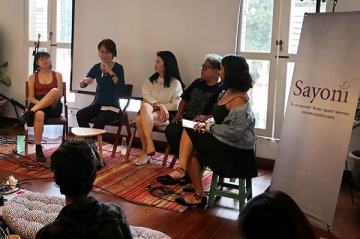1. The use of animals- especially rats.
It is uncertain how comparable the brains of rats are to humans’. For researchers have been unsuccessful, in locating sex differences found in rat brains, in human brains [3].
2. The human brain changes with age, environmental conditions and experience.
E.g. New nerve growth can be induced via introduction of challenges into the environment of elderly men and women [2].
3. The chicken and egg question:
Scientists are beginning to question whether structure determines function or function determines structure [3].
Simon LeVay, a neuroscientist, reported results of a study he conducted on the post-mortem tissue of the brains of 6 women and 16 men, whom he assumed are heterosexuals; and 19 men who had been homosexual (Journal “Science”, August 30, 1991). He found that one node of the anterior hypothalamus- which is the area in which scientists believe play a part in sexual behavior- was three times larger in heterosexual men as compared to homosexual men. The nodes in homosexual men were found to be closer to the size in that of heterosexual women.
After LeVay published his findings, the magazines and papers picked it up and there was (predictable) media hype over “Brain determines sexuality”. This has elicited both disdain and delight from the gay community.
Does that mean that sexuality is indeed determined by genetics?
Although there is a pool of research showing a genetic link to sexual orientation, these studies have failed to be replicated by other researchers, as well as that of LeVay’s [4]. Further more, it is important to note the limitations of the study done- the absence of lesbians in the study as well as the small sample size. Finally, it is unlike if the differences in the brain is caused by homosexuality or vice versa.
Nonetheless, the reach of such studies are far-reaching. Scientific studies are seen as “objective facts”; thus ascribed a power easily wielded as a political tool.
The bias in professional media reporting cannot be discounted. Eight months before LeVay’s results were published, Swaab and Hofman (1990) found that the suprachiasmatic neucleus of the hypothalamus is larger in homosexual men than heterosexual men [5]. However, between december 1990 to march 1993, LeVay’s results were given substantially more mention in newspapers and magazines (in the states). This discrepancy is also found in scientific journals [6]. It has been suggested that the need for scientists to believe that homosexual men resemble heterosexual women more than heterosexual men gave rise to this phenomenon. (Very degrading if you ponder a bit more- they are “saying” that women are inferior in some sense.) Thus, scientists’ preference for support for their preconceived ideas is a major determinant of what penetrates our newspapers and comes to be accepted as “fact” by the layperson.
Personal note:
What does it matter if such studies, even if fine-tuned down to detail, says that women are generally “intellectually weaker” than men and that homosexual men are like women (in tune with what homophobes and male chauvinists want to believe)?
“But but but… it’s the values of the scientist that cause the results to sway this way etc.”
Yes, it is possibly true…
We can argue forever, till our faces are blue.
And nothing gets done; more brain cells die in the process…
I can’t be bothered.
There will always be living exceptional lesbians/gays (and indeed there are many of us).
We will continue to shine.
Let those who can see decide on the validity of generalizations of such studies.
———————–
[1] Fausto-Sterling, A. (1985). Myths of gender. New York: Basic Books; Gould, S. J. (1980). The pandas’ thumb. New York: W. W. Norton; Harrington, A. (1987). Medicine, mind, and the double brain. Princeton, NJ: Princeton University Press.
[2] Cowell, P. E., Turetsky, B. I., Gur, R. C., Grossman, R. I., Shtasel, D. L. & Gur, R. E. (1994). Sex differences in aging of the human frontal and temporal lobes. Journal of Neuroscience, 14, 4748-4755.
[3] Blum, D. (1997). Sex on the brain. New York: Viking.
[4] Marshell, E. (1992). Sex of the brain. Science, 257, 620-621; Risch, N., Wheeler, E. S. & keats, B. J. B. (1993). Male sexual orientation and genetic evidence. Science, 262, 2063-2065; Spanier, B. (1995). Biological determinism and homosexuality. NWSA Journal, 7, 54-71.
[5] Swaab, D. & Hofman, M. (1990). An enlarged suprachiasmatic nucleus in homosexual men. Brain research, 537, 141-148.
[6] Levitt, F. (2001). Evaluating scientific research: separating fact from fiction. Long Grove, Illinois: Waveland Press.




Comments
July 3, 2006 at 12:56 pm
There is a major flaw with LeVay’s work, and that is that he used brains of AIDS patients to do his experiment. That’s not very reliable.
RSS feed for comments to this post